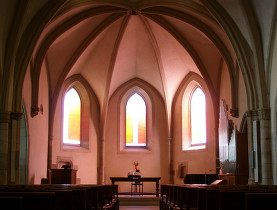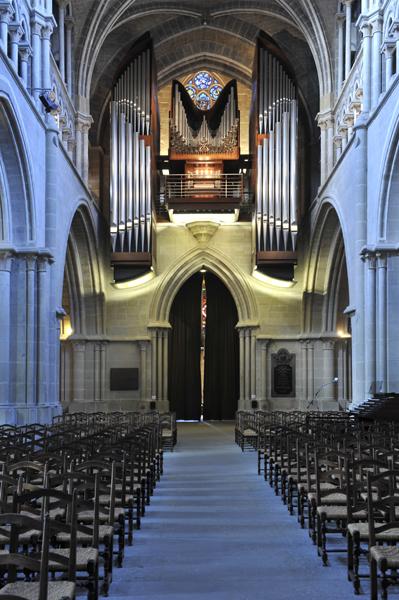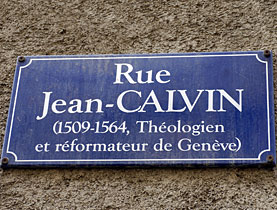Calvin auditorium appeals for organ donations

The Auditoire de Calvin in Geneva, where John Calvin taught and led the Protestant Reformation, has launched a campaign for a new king of instruments.
July 10 is Calvin’s 500th birthday and to mark the occasion the Auditoire wants to replace the current “inadequate” organ with one worthy of the oldest international meeting place in Geneva.
“It’s such a lovely building with so much atmosphere. It deserves better,” Rebecca MacDonald, one of three organists at the Auditoire, told swissinfo.ch.
Calvin designated the Auditoire as a place of worship for expatriate, refugee communities who flooded to Geneva after it accepted the Reformation in 1535.
John Knox, Calvin’s friend and founder of Scottish Presbyterianism, also preached in the 13th-century building, tucked next to the St Pierre Cathedral in the centre of the city’s Old Town.
Today the Auditoire is home to three congregations, the biggest of which is the presbyterian Church of Scotland. The Dutch Reformed and Italian Waldensian Churches are the two other tenants.
In addition to religious services, the Auditoire hosts many choral and chamber concerts. However, the limitations of the current organ, built in 1963, make it impossible for solo recitals and “less than ideal” for accompaniment, according to the Association for the New Organ of the Auditoire de Calvin (AOAC).
“The acoustics are lovely but there is a problem with the projection of sound from the present organ,” MacDonald said.
“It’s just inadequate. It’s missing a whole octave on the manuals which means it’s hard to play a lot of pieces. Also it doesn’t have enough room where it’s built to include many pipes, so we’re limited to only ten stops. This results in a very unversatile sound.”
The AOAC said a larger and more versatile instrument would attract organists from around the world and benefit both the city of Geneva and the Reformed Church international community.
Pipe sponsor
The association is therefore appealing to church members and music lovers around the world to chip in and hit the target of SFr600,000 ($530,000).
The objective is to replace the present instrument with a two-manual, 1,000-pipe mechanical-action organ. It would be built in the same location, the northeast corner of the nave, but will be designed to project sound more evenly through the church.
“We really need to find some major donors,” said David Asbury, who when not playing the Auditoire organ is a physicist at nearby Cern, the European Organization for Nuclear Research.
To that end, people are encouraged to become “pipe sponsors”: SFr100 will give a loving home to a small inside pipe and SFr1,500 a large façade pipe (see link). It is also possible to sponsor other pipes or organ parts – or simply make a donation.
Baroque
Once the collection pot has been filled, the task of building “the best instrument you can with the space you’ve got” will fall to renowned French organ-builder Bernard Aubertin.
MacDonald said her French conversion came after playing on Aubertin’s organ in the Saint-Louis en L’Ile church near Notre Dame in Paris.
“I just fell in love with it! It was the most beautiful organ I’d ever heard,” she said. “I then set about convincing everyone else [to choose Aubertin] – and finally they gave in!”
Asbury added that they also considered several leading Swiss organ builders, including Aeschlimann, Kuhn and Füglister. In the end it came down to Aubertin and Aeschlimann.
“Aubertin thinks more towards German baroque music; Aeschlimann I think was tending a bit more towards the English tradition, a slightly more mellow sound,” he told swissinfo.ch.
“They’re both very, very good indeed and we would be very pleased to have either. It would make such a huge difference.”
Work of art
Aubertin himself confirms that the new organ will have a baroque character, “but with some flexibility”.
“The many 8ft [2.44 metre] and 4ft pipes will bring a lot of possibilities for playing baroque and early music up to Mendelssohn [in the first half of the 19th century],” he told swissinfo.ch.
“But in no case will it be a romantic or symphonic organ, which you find in the second half of the 19th century and early 20th century. A romantic symphonic organ needs space and is more like a machine than a musical instrument.”
Aubertin, who set up his company in 1978 aged just 25, says he is delighted to be working in a building with “spirit”.
“I build organs all over the world in countries where the churches are modern buildings made out of concrete, steel beams and glass without any spirit of time. Here we have an old building which is filled with spirit.”
Organs for him are definitely works of art – all his organ cases are made of solid oak, are hand-finished and often display elegant ornamentation – and he has strong opinions about their appearance.
“I’m not interested at all in organs which can be considered a piece of church equipment like microphones or the heating,” he said.
“An organ must be a source of benevolence. It must not be boring. And it must not look like a profanation. Some modern cases look like bus shelters. It’s like finding a hair in your soup!”
“Mirrors of society”
When looking for inspiration, Aubertin uses all his senses.
“With my largest organ, in Saint-Louis en L’Ile, I walked around the church, sat in the pews, sniffed the walls – trying to hear what they wanted to tell me,” he said.
“It’s very difficult – sometimes they have nothing to say, but you must listen. And when you are wrapped in the spirit of a building, ideas suddenly pop into your head and you start thinking of spiritual and symbolic architecture.”
He adds that organs are the “perfect mirrors of society”.
“When you visit and listen to a 19th-century organ, you can understand how people lived at the time – what their concerns and tastes were and so on.”
So will this the new organ at the Auditoire reflect the financial crisis? “I hope not because it would be rather empty!”
Thomas Stephens in Geneva, swissinfo.ch
The largest organ in Switzerland is in the Klosterkirche in Engelberg, which has four manuals and 9,097 pipes.
By contrast, the largest organ ever built, at the Atlantic City Convention Hall in the United States, has seven manuals and more than 32,000 pipes.
The oldest playable organ in the world is thought to be in the church of Notre-Dame-de-Valère in Sion, canton Valais. Its oldest parts date back to 1435, but they include only most of the case and no more than 12 original pipes.
The most expensive organ in Switzerland is the SFr5 million instrument in Lausanne Cathedral, which was inaugurated in 2006. It is the first organ to feature four styles, the first to have been designed by a designer (Giugiaro), and the first in a European cathedral to have been constructed by a US company.
This year marks the 500th birthday of the religious reformer whose ideas shaped the Protestant Church. In his honour Protestant denominations have designated 2009 Calvin Year.
A selection of the main Geneva events; see website for full list:
April 24-October 31: “A day in the life of Calvin” exhibition at International Museum of the Reformation, Geneva
July 1-26: John Calvin theatre play by François Rochaix, Reformers’ Wall, Geneva.
July 1-26: Huguenot village exhibition, Reformers’ Wall, Geneva
July 10: 500-year anniversary ceremony to mark the 500th anniversary of Calvin’s birth, Reformers’ Wall, Geneva.
August: Open air street theatre in Geneva Old Town.
October 1-3: “Airport Chapel” theatre play by Sketch’Up, Theatre de L’Espérance, Geneva.
November 1: Concert at St Pierre Cathedral, Geneva.

In compliance with the JTI standards
More: SWI swissinfo.ch certified by the Journalism Trust Initiative














You can find an overview of ongoing debates with our journalists here . Please join us!
If you want to start a conversation about a topic raised in this article or want to report factual errors, email us at english@swissinfo.ch.